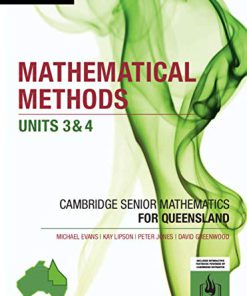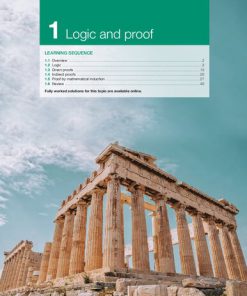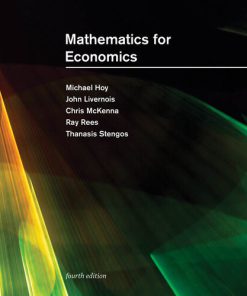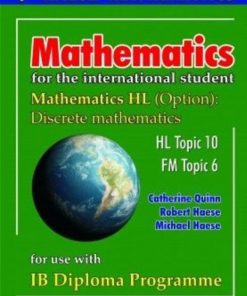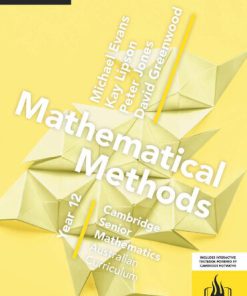Specialist Mathematics Units 1 and 2 20th Edition by Michael Evans, Douglas Wallace, Kay Lipson, David Treeby ISBN 1107567653 9781107567658
$50.00 Original price was: $50.00.$25.00Current price is: $25.00.
Specialist Mathematics Units 1&2 20th Edition by Michael Evans, Douglas Wallace, Kay Lipson, David Treeby – Ebook PDF Instant Download/Delivery: 1107567653, 978-1107567658
Full download Specialist Mathematics Units 1&2 20th Edition after payment
Product details:
ISBN 10: 1107567653
ISBN 13: 978-1107567658
Author: Michael Evans, Douglas Wallace, Kay Lipson, David Treeby
Specialist Mathematics Units 1&2 20th Edition:
Specialist Mathematics Units 1&2 20th Edition Table of contents:
-
1. Reviewing algebra
- Indices
- Standard form
- Solving linear equations and simultaneous linear equations
- Solving problems with linear equations
- Solving problems with simultaneous linear equations
- Substitution and transposition of formulas
- Algebraic fractions
- Literal equations
- Using a CAS calculator for algebra
- Review of Chapter 1
-
2. Number systems and sets
- Set notation
- Sets of numbers
- Surds
- Natural numbers
- Problems involving sets
- Review of Chapter 2
-
3. Sequences and series
- Introduction to sequences
- Arithmetic sequences
- Arithmetic series
- Geometric sequences
- Geometric series
- Applications of geometric sequences
- Recurrence relations of the form tn = rtn–1 + d
- Zeno’s paradox and infinite geometric series
- Review of Chapter 3
-
4. Additional algebra
- Polynomial identities
- Quadratic equations
- Applying quadratic equations to rate problems
- Partial fractions
- Simultaneous equations
- Review of Chapter 4
-
5. Revision of Chapters 1–4
- Technology-free questions
- Multiple-choice questions
- Extended-response questions
- Investigations
-
6. Proof
- Direct proof
- Proof by contrapositive
- Proof by contradiction
- Equivalent statements
- Disproving statements
- Mathematical induction
- Review of Chapter 6
-
7. Logic
- The algebra of sets
- Switching circuits
- Boolean algebra
- Logical connectives and truth tables
- Valid arguments
- Logic circuits
- Karnaugh maps
- Review of Chapter 7
-
8. Algorithms
- Introduction to algorithms
- Iteration and selection
- Introduction to pseudocode
- Further pseudocode
- Review of Chapter 8
-
9. Combinatorics
- Basic counting methods
- Factorial notation and permutations
- Permutations with restrictions
- Permutations of like objects
- Combinations
- Combinations with restrictions
- Pascal’s triangle
- The pigeonhole principle
- The inclusion–exclusion principle
- Review of Chapter 9
-
10. Revision of Chapters 6–9
- Technology-free questions
- Multiple-choice questions
- Extended-response questions
- Investigations
-
11. Matrices
- Matrix notation
- Addition, subtraction and multiplication by a real number
- Multiplication of matrices
- Identities, inverses and determinants for 2 x 2 matrices
- Solution of simultaneous equations using matrices
- Inverses and determinants for n x n matrices
- Simultaneous linear equations with more than two variables
- Review of Chapter 11
-
12. Graph theory
- Graphs and adjacency matrices
- Euler circuits
- Hamiltonian cycles
- Using matrix powers to count walks in graphs
- Regular, cycle, complete and bipartite graphs
- Trees
- Euler’s formula and the Platonic solids
- Appendix: When every vertex has even degree
- Review of Chapter 12
-
13. Revision of Chapters 11–12
- Technology-free questions
- Multiple-choice questions
- Extended-response questions
- Investigations
-
14. Simulation, sampling and sampling distributions
- Expected value and variance for discrete random variables
- Distribution of sums of random variables
- Populations and samples
- Investigating the distribution of the sample mean using simulation
- Review of Chapter 14
-
15. Trigonometric ratios and applications
- Reviewing trigonometry
- The sine rule
- The cosine rule
- The area of a triangle
- Circle mensuration
- Angles of elevation, angles of depression and bearings
- Problems in three dimensions
- Angles between planes and more difficult 3D problems
- Review of Chapter 15
-
16. Trigonometric identities
- Reciprocal circular functions and the Pythagorean identity
- Compound and double angle formulas
- Simplifying a cos x + b sin x
- Sums and products of sines and cosines
- Review of Chapter 16
-
17. Graphing functions and relations
- The inverse circular functions
- Reciprocal functions
- Graphing the reciprocal circular functions
- The modulus function
- Locus of points
- Parabolas
- Ellipses
- Hyperbolas
- Parametric equations
- Polar coordinates
- Graphing using polar coordinates
- Review of Chapter 17
-
18. Complex numbers
- Starting to build the complex numbers
- Multiplication and division of complex numbers
- Argand diagrams
- Solving quadratic equations over the complex numbers
- Solving polynomial equations over the complex numbers
- Polar form of a complex number
- Sketching subsets of the complex plane
- Review of Chapter 18
-
19. Revision of Chapters 15–18
- Technology-free questions
- Multiple-choice questions
- Extended-response questions
- Investigations
-
20. Transformations of the plane
- Linear transformations
- Geometric transformations
- Rotations and general reflections
- Composition of transformations
- Inverse transformations
- Transformations of straight lines and other graphs
- Area and determinant
- General transformations
- Review of Chapter 20
-
21. Vectors in the plane
- Introduction to vectors
- Components of vectors
- Scalar product of vectors
- Vector projections
- Geometric proofs
- Applications of vectors: displacement and velocity
- Applications of vectors: relative velocity
- Applications of vectors: forces and equilibrium
- Vectors in three dimensions
- Review of Chapter 21
-
22. Revision of Chapters 20–21
- Technology-free questions
- Multiple-choice questions
- Extended-response question
People also search for Specialist Mathematics Units 1&2 20th Edition:
specialist mathematics units 1&2 for queensland
specialist mathematics units 1 and 2 pdf
what is 2 unit maths
2 unit maths syllabus
how many units is standard maths
Tags:
Michael Evans,Douglas Wallace,Kay Lipson,David Treeby,Specialist,Mathematics
You may also like…
Uncategorized
Jacaranda Maths Quest 12 Specialist Mathematics VCE Units 3 4 Second Edition Jacaranda
Business & Economics - Mathematical Economics
Uncategorized
Mathematics - Discrete Mathematics
Mathematics - Algebra
Religion & Spirituality - Christianity
Empowered by Praise 20th Anniversary Edition by Michael Youssef ISBN 9781629999883 1629999881



